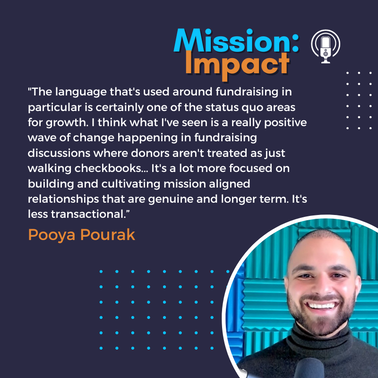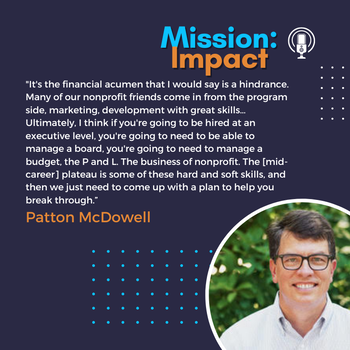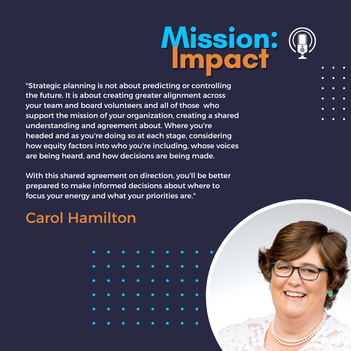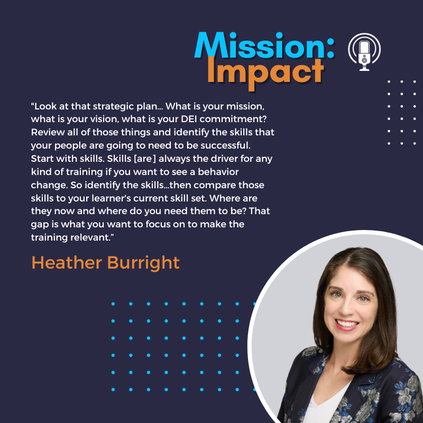Mission: Impact podcast & blog
Build a better world without becoming a martyr to your nonprofit cause
Listen on:
|
As a nonprofit executive director or leader, you know what you believe to be true about your organization. What its strengths and challenges are, its areas for growth and assets to build on. But what about others involved in your organization, like board members, staff and community members? Does your assessment align? When you are part of the organization’s leadership, your take on how things are going may be quite different from line staff and others further away from decision-making circles. It can also be challenging to get candid feedback from those below you in the organizational structure. One way to learn where you are on the same page and where the gaps are is to complete a nonprofit organization assessment. What is a nonprofit organization assessment?A nonprofit organizational assessment is a third party assessment of your organization, gathering feedback from all your key stakeholders. The goal of the process is to get an accurate assessment of a nonprofit organization's current state. Any organizational assessment will be a snapshot in time synthesizing the feedback of stakeholders. With the final report in hand, you will be able to make better informed decisions about what your key next steps are for your organization. Why should my nonprofit conduct an org assessment?Gathering candid 360 feedback on your nonprofit organization Making the time to engage in a comprehensive nonprofit organizational assessment with a stakeholder analysis gives you the opportunity to get feedback from all your stakeholders and get a 360 perspective on your organization. Working with a consultant to conduct the assessment will ensure that you get more candid feedback. Stakeholders will be more likely to share perspectives with someone outside the organization more directly and frankly. A comprehensive nonprofit organizational assessment provides a rigorous process for getting those views out in the open. Conducting one in-house may mean that you only learn what people think you want to hear. Good practice among high performing nonprofits Conducting a thorough organizational assessment with a focus on stakeholder analysis is a vital practice that sheds light on the multifaceted perceptions of those who interact with your organization at various levels. This is one of the reasons it is considered good practice among high performing organizations. Eight key focus areas of a nonprofit organizational assessmentEight key areas of focus for an overall organizational assessment are your organizational culture, perceptions of your organization’s strengths and areas for strengthening and growth, the workings of your board of directors, staff and volunteer experience and engagement, how decisions are made, as well as stakeholders’ aspirations for the future. Based on conversations with your organizational leadership, there may be additional areas of inquiry that are pertinent at the particular time of the assessment. Mapping your ecosystem: Stakeholder analysisThe initial step to conducting an organizational assessment is to map out your organization’s stakeholders. Who has a stake in your organization’s future? Who are the people and/or groups of people who care about your organization and its mission? These likely include staff and your board of directors at a minimum. Also included are volunteers, those you serve or support, donors, funders, other organizations that you partner with, other related organizations that provide complementary programs to yours, government agencies, policy makers, the community you are situated within and others. Mapping out the ecosystem of people and organizations engaged with your nonprofit provides you with a picture of the network of stakeholders who can help you succeed in pursuing your purpose. In this process, you may also identify individuals and groups who are not yet connected with your organization that could be helpful in achieving your mission. Methods for conducting an organizational assessmentEngaging stakeholders to gather input could happen in a variety of ways. These include 1-1 interviews, focus groups and surveys. The exact combination of approaches will depend on the focus of the assessment as well as the scope of the organization. Stakeholder Interviews Having a consultant conduct 1-1 interviews as part of the organizational assessment provides stakeholders with a confidential and safer space to share their perspectives. Interviews may vary in focus and length depending on the stakeholders. Stakeholder Focus Groups When a consultant facilitates focus groups for your organization, you can hear from a larger group of people that represent a segment of your stakeholders. Those participating in the focus group will learn about their counterparts’ perspectives and conversation may be generated during the focus group as people participating build on each other’s ideas. Participants may be more reticent to share their opinions in a group setting than 1-1. Both interviews and focus groups provide the opportunity to follow up with additional clarifying questions as well as questions to dig deeper to gain more insight into the person/groups’ viewpoint. Thus, both these methods enable you to gain further insights into the lived experience of those participating. Stakeholder Surveys Having a consultant design and conduct a survey for your organization, you can gather information from an even larger group of people. The survey can also be designed to gather input from a variety of stakeholders as the survey can be designed in a way to have certain questions only be answered by individuals who fit certain criteria. Surveys provide you with the opportunity to gather comparative and quantitative data. Drawbacks to surveys include possible lower response rates and the limited capacity to gather input in the respondent’s own words. Including too many open-ended questions in a survey will make it less likely that respondents answer or fully complete the survey. The length and complexity of the survey can also impact the response rate. In addition, it is not possible to follow up in the survey itself for clarification or elaboration as it is in an interview or focus group. Thus combining a survey with interviews and focus groups provides the opportunity to go deeper. Wider Community Engagement As part of the organizational assessment, you may choose to take a wider look at the community you are situated in and conduct a community assessment as well. Again, a stakeholder analysis, design of the inquiry, choice of methods (interviews, focus groups, surveys) would all be steps in the process. Moving from insight to action: How a nonprofit organizational assessment can help kick start your nonprofit’s next strategic plan. Once an organizational assessment is complete, the consultant will share the synthesis of the input that has been gathered in a set of findings. Typically, this will happen as one or a series of facilitated sessions. This could include a cascade sharing the findings with leadership and then staff, board, and other stakeholders. Once the findings have been shared, the group will need to make meaning of it. You heard “what” in terms of the themes coming out of the feedback – and often – a set of recommendations from the consultant. What meaning do you make of this? What surprises you? What confirms what you were already thinking? What are the implications of these findings for your organization? What next steps or actions do you need to take based on the assessment? A nonprofit organizational assessment is the first step in a strategic planning process, so in deciding what your next steps are you may decide you are well positioned to engage in strategic planning for your next 3-5 years. Related posts: Strategic planning process for nonprofits: 5 steps to a plan that supports your vision Bringing issues out in the open Often people are surprised by the level of commonality and agreement within the findings. Though they may not yet have shared these thoughts and attitudes out loud with colleagues, they learn that others are thinking similar things to them. The assessment provides context and opportunity to get those views out in the open and on the table. It creates space to have conversations and discuss issues that may not emerge in the day to day running of your organization. When there are challenging issues to confront, having a consultant conduct the assessment and facilitate the dialogue about the findings provides a safer psychological space to have the hard conversation that needs to happen to make progress. Closing the loop with all stakeholders Stakeholders engaged in the process of gathering data all need to hear something back about the process. You will likely share different levels of detail from the findings with different stakeholder groups. But it is critical to close the loop with anyone you involve in the process. One of the benefits of engaging stakeholders in an assessment is that it can strengthen the relationship with your organization. Yet if those stakeholders do not hear anything back about the results, it can actually have a detrimental impact on the relationship. Let them know highlights of what you heard and even more importantly what you plan to do based on the feedback. The benefits and outcomes of a nonprofit organizational assessmentThe insights garnered from confidential interviews, dynamic focus groups, and comprehensive surveys, especially when guided by an external consultant, can unveil truths that may not surface in everyday internal communications. With candid feedback, facilitated by a consultant's neutral stance, nonprofits can navigate the delicate intricacies of internal and external expectations. It's a process that fosters a culture of transparency, encourages inclusive dialogue, and strengthens the collective resolve to advance the mission.
With the findings in hand, the real work begins—interpreting the 'what' to discern the 'so what' for your organization. This critical evaluation leads to the 'now what,' where the synthesis of feedback and recommendations propels informed decision-making. It's a moment for collective reflection, and a chance to align your nonprofit's trajectory with the genuine needs and aspirations of your stakeholders. As the assessment culminates and you translate the feedback into actionable insights, you tap into the collective wisdom and engagement of your stakeholders with every person linked to the nonprofit's vision. This isn't just about closing the feedback loop; it's about opening a gateway to continuous improvement and impactful change.  In episode 93 of Mission: Impact, Carol Hamilton and Pooya Pourak discuss the importance of transparent, impact-centric fundraising, the use of technology for efficiency, and the necessity of fair compensation for nonprofit employees. They delve into the nuances of donor engagement, exploring how to shift from a scarcity mindset to one of abundance and collaboration. They also discuss the potential of AI in the sector, while maintaining the human element that is essential to nonprofit work. Episode Highlights: 09:40 - Donor Engagement and Trust: Pooya presents statistics on donor engagement and trust, highlighting the disconnect between nonprofits and donors, and the strategies to improve transparency and communication. 12:00 Language and Fundraising: The conversation shifts to the language used in fundraising and how it affects donor relationships. They discuss the importance of genuine, mission-aligned connections over transactional interactions. 14:00 Shifting Status Quo Assumptions: Carol and Pooya discuss how nonprofits can break free from counterproductive practices and adopt strategies that promote long-term sustainability and diversified fundraising sources. 16:30 Nonprofit Ecosystem Complexity: Pooya reflects on the complexity of the nonprofit ecosystem, including the roles of various stakeholders, from other nonprofits to donors, foundations, and policy. 22:00 Testing Hypotheses in Fundraising: Pooya details the testing of two hypotheses aimed at increasing generosity and online giving, including the influence of unrestricted donations and the effectiveness of matching gifts. 31:00 The Future of the Nonprofit Sector: Looking ahead, Pooya anticipates the growing role of AI in the sector and emphasizes the need to balance technological advances with maintaining the sector's human-centered approach. 34:00 Fair Compensation The interview concludes with Pooya advocating for fair compensation in the nonprofit sector and encouraging a shift from competition to collaboration to enhance collective impact. Guest Bio:
Pooya Pourak Pooya is co-founder and CEO of MatchNice, a social impact tech startup on a mission to connect the nonprofit ecosystem and maximize social impact. His team is working on a new kind of impact-centric fundraising platform to increase transparency, engagement and accountability in digital fundraising. Pooya brings 15+ years of experience leading digital transformation across business, government, and now the nonprofit sector. He is the Host and Producer of The Nonprofit Lab, a podcast dedicated to the journey of discovery in the nonprofit sector with an aim to uncover and shake up the status quo. Pooya runs his own consulting practice where he helps our government listen to the needs of diverse stakeholders and put their feedback into action to inform large-scale systems delivery. Pooya holds a Bachelor of Science from Georgia Institute of Technology in Industrial & Systems Engineering and is also a certified yoga instructor. Important Links and Resources: https://www.matchnice.org/ https://www.linkedin.com/in/pooyapourak/ Charity Vest https://www.charityvest.org/ Google for Nonprofits https://www.google.com/nonprofits/ Click "Read More" to view a transcript of the interview.  In episode 92 of Mission: Impact, Carol Hamilton and Patton McDowell explore the multi-generational nonprofit workforce, discussing the unique hurdles and opportunities that come with each stage of a non-profit career—from emerging leaders grappling with gaining practical experience to mid-career professionals encountering a plateau, and up to executive directors feeling isolated at the top. They underscore the importance of adaptability, continuous learning, and the benefits of strategic personal planning. Show highlights: Generational Workforce Challenges - [00:07:00] Discussion on the challenges faced by different generations in the nonprofit sector. Opportunity and Experience for Emerging Leaders - [00:08:05] Patton talks about the emerging leader generation facing the issue of opportunity and joy market entry difficulties Mid-Career Plateau - [00:19:25] Patton introduces the idea of a "mid-career plateau" and how to overcome it. Non-Traditional Career Paths - [00:22:00] Carol discusses lateral moves and specialization as alternatives to traditional progression. Executive Leadership Loneliness - [00:24:22] Patton discusses the isolation felt by those in executive leadership roles. Co-Executive Director Model - [00:29:00] Carol asks Patton about shared leadership roles and his views on them. Predictable Turnover - [00:33:00] Carol reflects on predictable turnover and proactive recruitment approaches. Organizational Exchanges - [00:39:10] Patton and Carol discuss the benefits of organizational exchanges and site visits. Personal Retreat for Leaders - [00:42:20] Patton recommends nonprofit leaders take personal retreats for strategic planning and Carol speaks on her own practice of personal strategic planning. Guest Bio:
Patton is the Founder of PMA Nonprofit Leadership, a coaching and consulting firm specializing in leadership development, fundraising, and strategic planning for nonprofits. He led fundraising efforts at two universities after starting his career at Special Olympics International. He's a Master Trainer for AFP Global, hosts the podcast Your Path to Nonprofit Leadership, and authored a best-selling book of the same name. He holds a bachelor's degree from UNC Chapel Hill, an MBA from Queens University of Charlotte, and a Doctorate from the University of Southern California. Patton currently serves as an Executive in Residence at the Jeb E. Brooks School of Public Policy at Cornell University. Important Links and Resources: Patton McDowell - https://www.linkedin.com/in/pattonmcdowell/ PMA Nonprofit https://www.pmanonprofit.com/ Charlie Gilkey - https://www.productiveflourishing.com/ Click "Read More" for a transcript of the interview.  In episode 90 of Mission: Impact, Carol Hamilton goes solo and talks about:
Strategic planning:
Kick Off
Keeping the Plan Fresh
Important Links and Resources: Common Mistakes Organizations Make in Strategic planning: https://www.gracesocialsector.com/store/p13/strategic_plan_mistakes.html Be in touch ✉️ Subscribe to Carol’s newsletter at Grace Social Sector Consulting 💻 Give us feedback on the show 🌟 Like what you heard? Please help share the podcast by leaving a rating & review. 😀 Connect with Carol Hamilton ➡️ LinkedIn Identifying the skills your team needs to bring your strategic plan to life with Heather Burright10/30/2023
 In episode 84 of Mission: Impact, Carol Hamilton and Heather Burright discuss: how strategic planning, implementation and staff and volunteer skills development all fit together. We delve into the critical aspects of strategic planning and its effective implementation. I highlight the importance of aligning the implementation plan with the organization's regular processes and cycles, emphasizing the need for a shorter time frame for implementation, typically six months to a year. I also talk about the significance of continuous evaluation, tracking progress, and making necessary adjustments to ensure the successful execution of the plan. The conversation underscores the pivotal role of understanding and addressing the skills gap within the organization. Heather discusses how to identify the skill gaps that will undermine the success of your strategic plan and then the essential elements of creating a training program, focusing on relevance, meaningfulness, and a touch of fun to engage employees effectively. She emphasizes the importance of custom competency models and the value of building cross-functional relationships and trust within the organization to facilitate successful change management. Episode outline:
(00:07:07) Strategies for Successful Strategic Planning Implementation Planning (00:11:09) Integrating implementation into your regular practices (00:12:36) Why training is a key piece to strategic plan implementation (00:16:11) Maximizing Impact Through Whole Organization Involvement (00:24:29) Listening to People: Key to Change Management Guest Bio: Leveraging 15 years of experience, Heather Burright, founder and CEO of Skill Masters Market, specializes in creating dynamic, people-centric solutions that drive business goals. With her comes expertise in strategies for diversity, equity, and inclusion; instructional design; and change management. She’s dedicated to identifying core competencies that are needed to see real results and to creating the learning strategies and solutions needed to develop those competencies. Important Links and Resources: Heather Burright: https://www.linkedin.com/in/heather-burright/ Skills Masters Market: https://www.skillmastersmarket.com/ Learning for Good podcast: https://podcasts.apple.com/us/podcast/learning-for-good-podcast-learning-and-development/id1621971310 Standards for Excellence Institute: https://standardsforexcellence.org/ |
Archives
April 2024

Grace Social Sector Consulting, LLC, owns the copyright in and to all content in and transcripts of the Mission: Impact podcast, as well as the Mission: Impact blog with all rights reserved, including right of publicity.
|
Telephone301-857-9335
|
info[at]gracesocialsector.com
|
Grace Social Sector Consulting, LLC, owns the copyright in and to all content in, including transcripts and audio of the Mission: Impact podcast and all content on this website, with all rights reserved, including right of publicity.
|